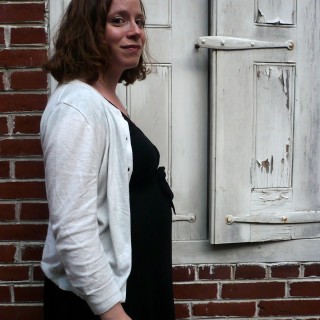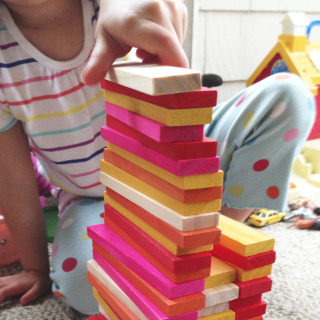The Longest Shortest Time
How to Build a Baby
Something that has terrified me ever since Sasha turned three is the idea that she is now capable of forming memories that will stick. She doesn’t remember breaking her leg; she doesn’t remember the neighbors she used to play with every single day when she was one and two . . . and zero. But from here on out, she will most likely remember the times that I lose my temper or say something the wrong way. I try to be careful. But, y’know, sometimes you just can’t help what comes out of your mouth.
As Sasha’s been growing, I’ve been trying to formulate how I will talk to her about big things like sex and death. She still doesn’t know anything about dying, but the sex thing came up this summer—way sooner than I’d expected. Pretty much all of Sasha’s friends have little siblings at this point. My brother also had a baby this summer, and after visiting baby Hana one day, Sasha came home and wanted to see pictures of me pregnant. She giggled at my growing belly, and tried to imagine what exactly she was doing in there. I was clicking through the pictures trying to think up an answer for how she made it out of my belly, in case she asked. Turned out, she wasn’t as interested in how she got out as where the hell she was before she got in. You weren’t here yet just raised more questions for her.

“But how do you get the baby inside the mommy’s belly?” she asked.
“The daddy has sperm, and the mommy has an egg,” I told her.
“The sperm goes inside the mommy and finds the egg and the baby starts to grow.”
Old hat. She had heard this from me before. She wanted to see what the sperm and egg looked like, so I went looking on YouTube and found some scientific video depicting the whole ordeal.
“See?” I said. “It’s much, much smaller than that, but that’s how it works. Sperm and egg.”
“I know sperm and egg,” she said, stomping her foot in frustration, “But how do you BUILD the baby?” I had never seen her so desperate for knowledge.
I could tell her the truth, I thought. But will it scare her? Will this be one of those things that I say that fucks her up? I decided to go and get my old childhood copy of Where Did I Come From? by Peter Mayle. Which I quickly realized would be better for a slightly older audience.

“Sperms have eyes?” she asked, stunned.
“No, honey, they don’t. The eyes are in the pictures just to make them look friendly. The thing they’re showing you is that the sperms go into the mommy to make the baby.” I quickly bypassed the page of the mommy and daddy doing it.
“But how do the sperms get into the mommy?”
“They just do.” Believe it or not, that answer sometimes ends her interrogations.
Not this time. “But how?” She was really shouting by now.
Ack. What to say? How to say it? “The penis just . . . puts them there.” Good enough?
“Where?” No, not good enough, I guess.
“In the mommy’s vagina.” Are we done yet?
“How does the penis put them in the vagina?” Nope, not yet. Deep breath. Will I really tell her? “The penis goes . . . insidethevaginaandputsthemthere.” Yes. Yes, I will.
I regretted saying those words the second they escaped my lips. Maybe because they seemed to stop her in her tracks. No more questions. She just turned to her books and started looking for something else to read. But what was I supposed to say? I felt like she had backed me into a corner. Then again, she was only three. Shouldn’t I have been able to say something that would satisfy her curiosity without freaking her out?
I wound up using this as an opportunity to go to the library. I told the children’s librarian that Sasha was interested in learning about how babies are built, and did she have any book recommendations to help Sasha learn about the building process? I walked out with a nice little stack, some of which were recommended to me by you guys on my Facebook page (I will post my list of favorites on Friday). The cool thing is, it turns out there are lots of great resources about baby building for kids. The bummer is, I think the books were freaking Sasha out even more. The giant colorful pictures of sperms and eggs continued to give her the creeps, as did pictures of smiling naked people, so we set the books aside and I called Alyson, the social worker I call from time to time when I’m feeling lost. Alyson said she was certain that my little sex talk with Sasha hadn’t had as big of an impact on her as I was imagining. But that it was best to back off of the books and images. Toddlers, she told me, have their own ideas about how the world works, and the most productive thing to do would be to ask her what she was imagining and use that as our starting point for exploring this Very Big Question.
So the next day I turned the question around: “Sasha, how do you think you build a baby?”
“I’ll show you,” she said. And she did:

Done. Built. Maybe that stuff I told her really didn’t stick with her, I thought. But I didn’t feel completely off the hook until dinner one night recently, when Sasha gave me a sex ed lesson of her own.
“There are babies floating in bubbles in the sky, Mommy,” she told me, gesturing airily at the ceiling.
“Oh yeah?” I asked. “In bubbles?”
“Yes,” she said, with conviction. “Then they come down and they get into the mommies’ bellies. And they get into an egg. And then the egg CRACKS. And the baby comes out.”
Ahh, I see.
There will come a time—and it is probably not very far off—when Sasha will be ready to hear the version of the story that I told her. But for now, I like her version way better than mine. I wish I had known before to encourage her to tell her own story of the building of a baby. Now that I do, I think I am going to use this technique a lot. It’s so interesting to discover that when kids tell stories, they are not just for entertainment with funny plot twists, like in last week’s post, but they can also be incredibly healing—for both the kid and the parent. That might sound obvious, and is maybe something I should’ve learned from our Leg Book, but it feels very different to hear a kid telling a story with words than with cathartic pencil marks. Babies in bubbles. That would actually make a great picture. I’ll see if she’ll draw it.
Has anyone else used child-motivated storytelling as a way to work through big questions or problems?
The Longest Shortest Time may earn a small commission from products linked on this site. Using our affiliate links helps support our work.